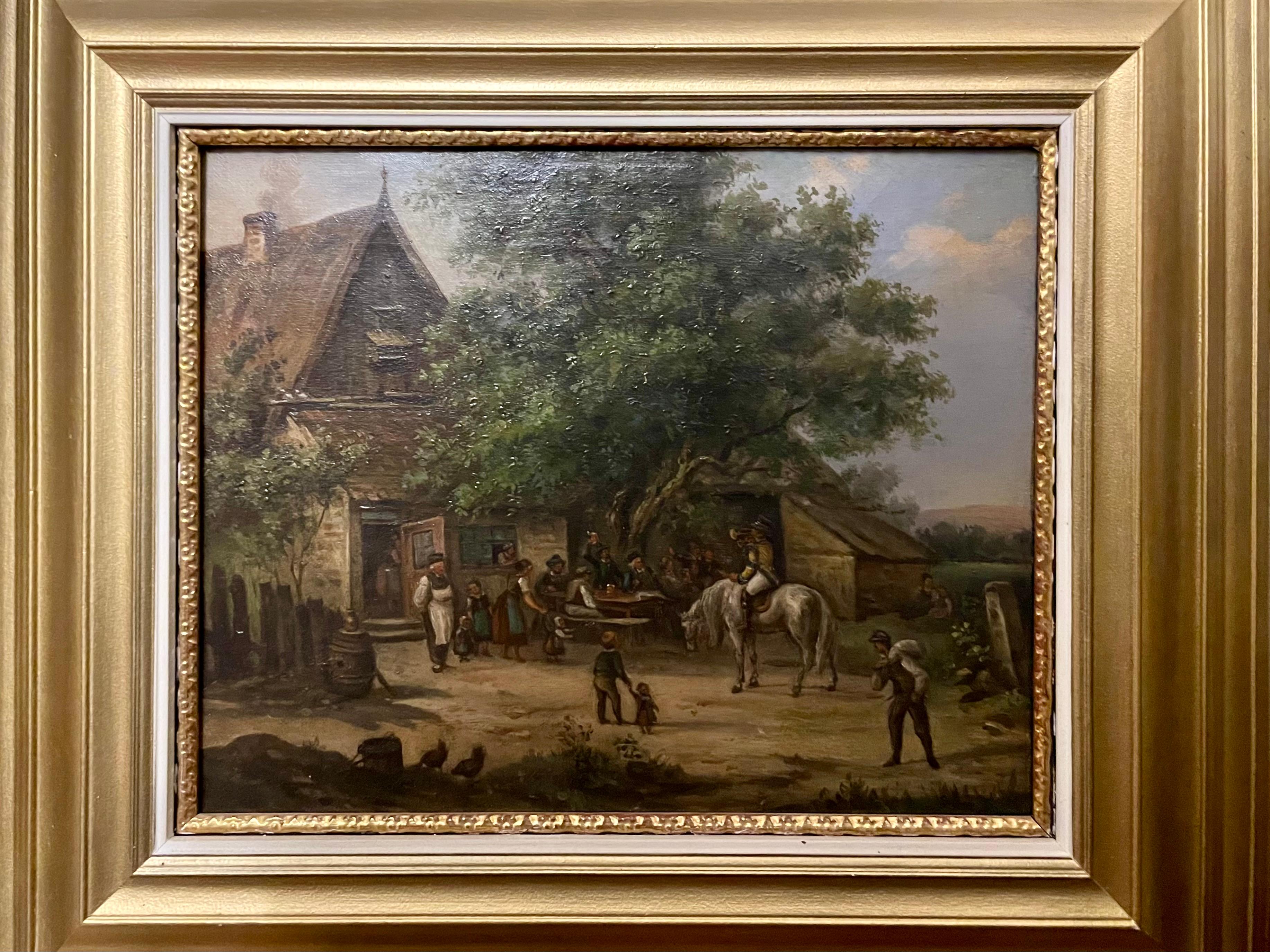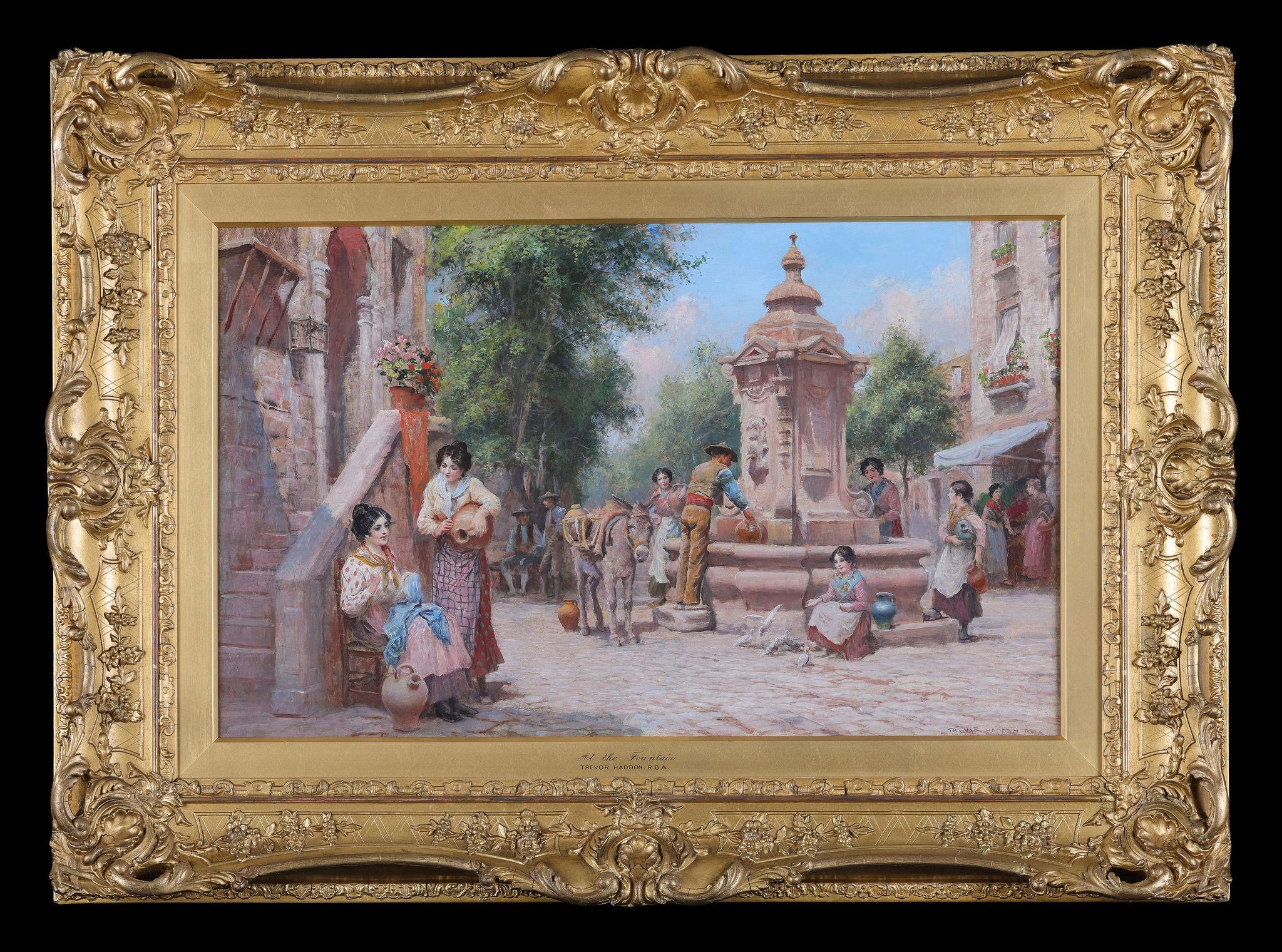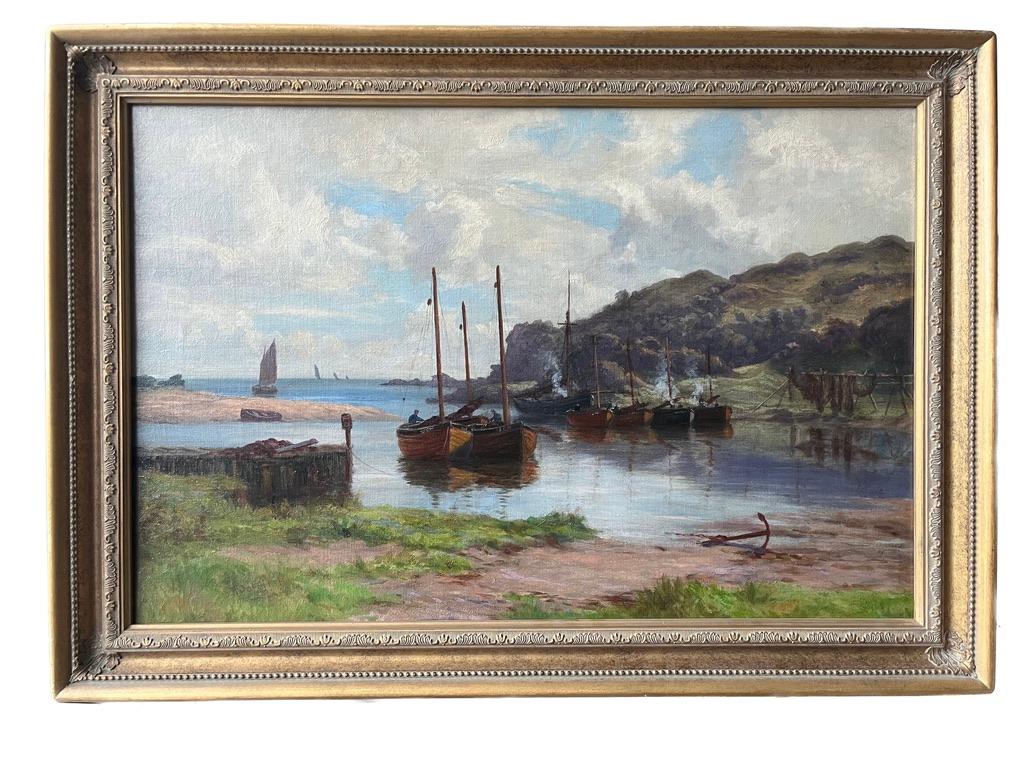Items Similar to David with the Head of Goliath, 19th Century Victorian Oil
Want more images or videos?
Request additional images or videos from the seller
1 of 6
John Rogers HerbertDavid with the Head of Goliath, 19th Century Victorian Oil1850
1850
About the Item
John Rogers Herbert RA
1810- 1890
Oil on canvas, dated '1850' lower right on sword strap
Image size: 33 ½ x 23 ½ inches
Gilt Watts frame
This striking painting, depicts David as a young boy holding behind his back the head of the champion of the Philistines, the giant Goliath, by the hair. The light catches on David's chest, arm and face, on the massive sword hilt of Goliath and the young tree behind, but everything else is quite dark. The two trees obviously represent David and Goliath, with the old larger tree dead and the green younger tree full of light and vigorous youth.
We see a very young courtier, a flamboyant youth of dazzling beauty and with a touch of arrogant defiance on his face. David is shown with his shepherds bag and stick, but also he holds a magnificently decorated but very heavy sword, given to him by King David. This sword evokes in the viewer the impression that the boy might have a great calling. David would indeed become the great warrior and king, the founder of the royal glory of Israel.
For a work painted in 1850 it has quite a surreal and modern feel to it and with its attention to detail you can see why he influenced the Pre Raphaelites.
The Artist:
John Rogers Herbert was born 23 January 1810 at Maldon in Essex. The family had enough money to send young Herbert to London when he was sixteen years old; and he was enrolled in the Royal Academy schools in December 1826. After the death of his father in 1828, Herbert was forced to give up the Academy school and began painting professionally – mostly book illustrations and portraiture. However, sketches from as early as 1829, such as Captives predict his later interest in larger historical subjects with challenging moral themes and complex compositions.
His first exhibit at the Royal Academy was in 1830, Portrait of a Country Boy.
Later in the decade, Herbert, like many of his contemporaries, displayed a growing interest in medievalism. One reason for this may be his friendship with A.W.N.Pugin who would become the co-architect of the Palace of Westminster and a proponent of medieval revival. Herbert and Pugin had known each other from childhood, and were very close, intimately involved in each other’s affairs.
At the age of 28 Herbert was already a success even painting a portrait of Princess Victoria in 1834. In 1841 Herbert was elected an Associate of the Royal Academy, and became a full member in 1846.
Herbert was a prolific teacher of art. In 1841 he became ‘master of the figure’ in the newly formed Government School of Design, a position probably owed to his artist friend William Dyce who was superintendent there, and with whom he collaborated in the illustration of Nursery Rhymes, Tales and Jingles.
Herbert was earnest and methodical in both his subjects and his technique. Evidence of this earnest practice can be found in the extensive research Herbert undertook for many of his paintings. He travelled to the East many times to paint the landscape, clothing and architecture of the area, in order to add authenticity to his biblical scenes.
Herbert’s innovative techniques, borrowing from mediaeval, German and Nazarene art influenced the young Herbert’s innovative techniques, borrowing from mediaeval, German and Nazarene art influenced the young Pre-Raphaelite Brotherhood. He instructed all the young members of the Brotherhood during their sojourn at the Royal Academy Schools, he gave personal support to James Collinson, and perhaps other members, during the formation of the Brotherhood, and was even a potential proprietor of The Germ. Yet, when W.M. Rossetti declared they wished to ‘out-Herbert Herbert’ he had more aesthetic and theoretical considerations in mind. The Pre-Raphelites drew on Herbert’s historical subjects of the 1840s for inspiration, and his influence can be especially seen in their early pictures.
- Creator:John Rogers Herbert (1810 - 1890, British)
- Creation Year:1850
- Dimensions:Height: 33.5 in (85.09 cm)Width: 23.5 in (59.69 cm)
- More Editions & Sizes:1 of 1Price: $30,717
- Medium:
- Movement & Style:
- Period:
- Condition:
- Gallery Location:London, GB
- Reference Number:1stDibs: LU5247319882
About the Seller
5.0
Vetted Seller
These experienced sellers undergo a comprehensive evaluation by our team of in-house experts.
Established in 2007
1stDibs seller since 2014
63 sales on 1stDibs
Typical response time: 3 hours
- ShippingRetrieving quote...Ships From: London, United Kingdom
- Return PolicyA return for this item may be initiated within 14 days of delivery.
More From This SellerView All
- Ophelia, Victorian 19th Century Royal Academy Oil PaintingLocated in London, GBOil on canvas, signed lower right Image size: 33 1/2 x 56 1/2 inches (85 x 143 cm) Original gilt frame Provenance With the artist's son, Millie Dow Stott Esq., until 1912. Artist's Studio Sale, Christies, November 1913. Private Collection Exhibitions London, Royal Academy, 1895, no. 679. Paris, Societe de la Nationale des Beaux-Arts, 1896, no. 1179. Berlin, VII Internationale Kunstausstellung 1897. no. 3533. Manchester, City of Manchester Art Gallery, 1912, no. 339. In the 1890s William Stott exhibited regularly at the Royal Academy, mainly highly decorative works with subjects derived from classical mythology and literature. This painting was Stott's 1895 entry to the Royal Academy and was subsequently exhibited at the Paris Salon of 1896 and then on to the Berlin, VII Internationale Kunstausstellung 1897. Shakespeare was a favourite source for Victorian painters, and the tragic romance of Ophelia, from Hamlet, was an especially popular subject, featuring regularly in the Royal Academy exhibitions. The most popular and iconic image of Ophelia's death was, and is to this day, John Everett Millais's 1851 painting showing the confused and tragic Ophelia floating downstream on her back in a state of mad ecstasy, arms raised in a gesture of inevitable submission. However, although Stott chose not to pastiche this image, it seems highly likely that he was prompted to take up this subject, which had almost become a 'rite of passage' among Victorian painters, by the fact that in 1894 Millais's Ophelia was presented to the National Gallery of British Art by Sir Henry Tate. It appears that Stott was much influenced by John William Waterhouse...Category
Late 19th Century Victorian Figurative Paintings
MaterialsOil, Canvas
- Study for Eastward Ho!, Oil on Panel 19th Century PaintingLocated in London, GBOil on panel Image size: 20 x 16 inches (51 x 40.5 cm) Handmade gilt frame Provenance Family estate This preliminary oil sketch for one of O'Neil's most famous works, "Eastward Ho!...Category
19th Century Victorian Figurative Paintings
MaterialsPanel, Oil
- Moonlight Scene with FishermenLocated in London, GBOil on canvas Image size: 23 1/2 x 18 1/2 inches (60 x 47 cm) Original frame This moonlit view features many of the usual features of Sebastian Pether's work: a painterly river, mountain scenery and the incorporation of classical gothic ruins in an attractive though artificial style. The ruins in the foreground and city in the background have been painstakingly depicted in meticulous detail. On the bank in the foreground, and out on the river itself, we see three night fishermen silhouetted against the calm waters. The artist has cleverly balanced the light emanating from the moon, and the reflection of this light glistening on the river surface below, to create the mysterious atmosphere of the moonlit evening. Indeed, he has skilfully employed the strong use of chiaroscuro effects of light and shade in this painting so that the eye is drawn to the full moon as it illuminates the sky. It is undeniably a work of Romanticism, a style that was popular around the beginning of the nineteenth century. The Artist Sebastian Pether was an English landscape-painter. He was the eldest son of Abraham Pether...Category
Early 19th Century Victorian Landscape Paintings
MaterialsOil, Canvas
- The WoodcutterBy Alfred EastLocated in London, GBAlfred East The Wood Cutter Oil on board Signed lower right and titled on back Image size: 10 1/4 x 15 inches (26 x 37.5 cm) Carved gilt frame This romantic landscape by East, certainly shows the influence that the Barbizon school had on his work. The Barbizon school were drawn together by their passion and desire to elevate landscape painting as a response to the Academic elevation of historical and mythological themes. Here, East truly revels in the beauty of the English landscape but also captures the mood of the time in which there was a growing concern at the rapidity of social change and its impact upon the countryside. East regularly painted the Cotswolds from the early 1890s until the end of his life - it is probable that this scenes depicts that part of the country. He focused principally on the area around Upper Swell, which he referred to as 'Over Swell', hoping to avoid the village becoming a focus for visitors seeking out the views that he portrayed. East adopted a well established three-stage-technique that made great use of the under-painting, a second layer concerned with the correction of values, and a final stage for the addition of details; all painted with lean oil paint. As can be seen in the work, during this process East practically repainted the entire canvas after the first layer and then proceeded to pick out isolated sections that required further reworking and detail. Provenance Pelter Sands Gallery Bristol, 1975 Exhibition of Twentieth Century British Painting. This work was part of Andrew Vicari...Category
Late 19th Century Victorian Landscape Paintings
MaterialsBoard, Oil
- Tempest 19th Century Oil British SchoolLocated in London, GBBritish School 19th Century TempestOil on board Image size: 9 1/2 x 12 1/2 inches (24 x 32 cm)Category
19th Century Victorian Landscape Paintings
MaterialsBoard, Oil
- Knole House, English School 19th Century Country House Landscape OilLocated in London, GBEnglish School 19th Century Knole House Oil on canvas Image size: 22 ½ x 35 ½ inches Gilt frame This is not only a very beautiful work of art but also a v...Category
1850s Victorian Landscape Paintings
MaterialsOil
You May Also Like
- Ezekiel in the Valley of Dry BonesBy Philip Burne-JonesLocated in New York, NYProvenance: Christie’s, London, 3 March 1922, lot 46 (with The Tower of Babel); James Nicoll Private Collection Sotheby’s, London, 29 March 1983, lot 157 Private Collection, New Yo...Category
Late 19th Century Victorian Figurative Paintings
MaterialsOil, Canvas
- Alone at the FerryLocated in Hillsborough, NC'Alone at the Ferry' is signed by British artist A.F. Patten (Alfred Fowler Patten 1826- 1889 or after). This is a fine oil on canvas painting of a young Victorian woman waiting for ...Category
1880s Victorian Figurative Paintings
MaterialsCanvas, Oil
- Village SceneLocated in Hillsborough, NCFine 19th century oil painting of bustling Austria/Germanic village with horse, rider and various figures outside an Inn, attributed to Arthur Georg Ramberg (1819-1879), well known for figurative paintings. The rider is apparently bringing news to the people; men sitting by the table drinking, women with children, people in the Inn doorway, one looking out the window. There is a great deal of detail in the scene, tree and Inn house...Category
19th Century Victorian Figurative Paintings
MaterialsCanvas, Oil
- At the FountainBy Arthur Trevor HaddonLocated in St. Albans, GBArthur Trevor HADDON 1864 - 1941 An excellent example of Haddon's work in its original frame. His finest pieces were painted during the time when he was living in Spain. Often they i...Category
Early 1900s Victorian Figurative Paintings
MaterialsOil
- Victorian landscape painting of the River Thames with horses wateringBy Edwin Henry BoddingtonLocated in Harkstead, GBA very atmospheric scene of a horse and cart crossing the river Wey (a tributary of the river Thames) under a beautiful twilight sky. There is wonderful detail and light with the ar...Category
19th Century Victorian Landscape Paintings
MaterialsOil, Canvas
- Victorian landscape painting of Scottish fishing boats moored in a bayLocated in Harkstead, GBA very tranquil scene of fishing boats moored in harbour with a sunlit sea beyond. Painted with a most attractive palette of blues and greens and with a pleasing composition that le...Category
19th Century Victorian Landscape Paintings
MaterialsOil, Canvas
Recently Viewed
View AllMore Ways To Browse
The Head
With The Head Of
Great Art Of The 19th Century
David M
David Head
Black Painted Victorian
Victorian Black Art
Paintings Victorian London
Head Of David
German 19th Century Oil
Oil Victorian Royal
Victorian King
King David
Chest With Painting
Oil W Royal
Very Large 19th Century Oil Painting
Victorian Family Painting
Large Victorian Gilt





